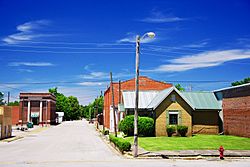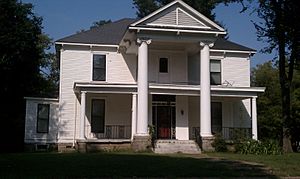Corning, Arkansas facts for kids
Quick facts for kids
Corning, Arkansas
|
|
|---|---|

Vine Street
|
|

Location of Corning in Clay County, Arkansas.
|
|
| Country | United States |
| State | Arkansas |
| County | Clay |
| Government | |
| • Type | Mayor-council government |
| Area | |
| • Total | 3.70 sq mi (9.58 km2) |
| • Land | 3.67 sq mi (9.51 km2) |
| • Water | 0.03 sq mi (0.08 km2) |
| Elevation | 292 ft (89 m) |
| Population
(2020)
|
|
| • Total | 3,227 |
| • Density | 879.05/sq mi (339.41/km2) |
| Time zone | UTC-6 (Central (CST)) |
| • Summer (DST) | UTC-5 (CDT) |
| ZIP code |
72422
|
| Area code(s) | 870 |
| FIPS code | 05-15460 |
| GNIS feature ID | 2404134 |
Corning is a city in Clay County, Arkansas, United States. The population was 3,377 at the 2010 census. It is one of the two county seats of Clay County, along with Piggott.
Contents
History
The original settlement was approximately one mile east and was called Hecht City, named for brothers Levi and Solomon Hecht, who operated a lumber mill on Black River. Hecht City moved to the present site of Corning in 1871, when the Cairo and Fulton Railroad surveyed the land for the proposed route. The railroad through the settlement was completed by 1872. On February 5, 1873, the name was changed from Hecht City to Corning, in honor of H. D. Corning, an engineer with the railroad.
The city of Corning experienced a massive period of growth in the early part of the 20th century. In the 1960s and 1970s, it was the site of many industrial manufacturing developments.
Corning was the site of a large explosion on March 9, 1966. The pre-dawn explosion originated in a munitions railcar and resulted in only one minor injury in the small town. The explosion was widely reported throughout the surrounding region.
Two properties in Corning are listed on the National Register of Historic Places: Sheeks House and Oliver House.
Geography
Corning is located in western Clay County 2 miles (3 km) west of the Black River. U.S. Route 62 passes through the city, leading east 25 miles (40 km) to Piggott and southwest 26 miles (42 km) to Pocahontas. U.S. Route 67 leads north from Corning 29 miles (47 km) to Poplar Bluff, Missouri, and joins US 62 heading southwest out of Corning to Pocahontas.
According to the United States Census Bureau, Corning has a total area of 3.14 square miles (8.14 km2), of which 3.12 square miles (8.08 km2) is land and 0.03 square miles (0.07 km2), or 0.81%, is water.
The topography of Corning is flat, having previously been marshland. Area farmers and builders may attest to this due to the proliferation of gumbo soil, a name given to soil high in clay particulate matter and common in the region.
Climate
The climate in this area is characterized by hot, humid summers and generally mild to cold winters. According to the Köppen Climate Classification system, Corning has a humid subtropical climate, abbreviated "Cfa" on climate maps.
According to the Köppen Climate Classification system, has a humid subtropical climate, abbreviated "Cfa" on climate maps. The hottest temperature recorded in Corning was 113 °F (45.0 °C) on August 8–9, 1934 and June 20, 1936, while the coldest temperature recorded was −25 °F (−31.7 °C) on February 12, 1899.
On January 22, 1918, Corning set the record for the highest 24-hour snowfall recorded in Arkansas at 25 inches.
| Climate data for Corning, Arkansas, 1991–2020 normals, extremes 1893–present | |||||||||||||
|---|---|---|---|---|---|---|---|---|---|---|---|---|---|
| Month | Jan | Feb | Mar | Apr | May | Jun | Jul | Aug | Sep | Oct | Nov | Dec | Year |
| Record high °F (°C) | 79 (26) |
84 (29) |
94 (34) |
95 (35) |
101 (38) |
113 (45) |
111 (44) |
113 (45) |
107 (42) |
98 (37) |
87 (31) |
78 (26) |
113 (45) |
| Mean maximum °F (°C) | 65.8 (18.8) |
70.7 (21.5) |
77.9 (25.5) |
84.5 (29.2) |
90.1 (32.3) |
95.3 (35.2) |
97.4 (36.3) |
97.2 (36.2) |
93.6 (34.2) |
86.9 (30.5) |
76.5 (24.7) |
67.1 (19.5) |
99.2 (37.3) |
| Mean daily maximum °F (°C) | 44.7 (7.1) |
50.1 (10.1) |
59.7 (15.4) |
70.6 (21.4) |
79.1 (26.2) |
87.1 (30.6) |
89.7 (32.1) |
88.7 (31.5) |
82.7 (28.2) |
72.2 (22.3) |
58.4 (14.7) |
47.8 (8.8) |
69.2 (20.7) |
| Daily mean °F (°C) | 36.4 (2.4) |
40.9 (4.9) |
49.8 (9.9) |
60.0 (15.6) |
69.4 (20.8) |
77.5 (25.3) |
80.4 (26.9) |
78.7 (25.9) |
71.6 (22.0) |
60.6 (15.9) |
48.8 (9.3) |
39.7 (4.3) |
59.5 (15.3) |
| Mean daily minimum °F (°C) | 28.2 (−2.1) |
31.7 (−0.2) |
40.0 (4.4) |
49.5 (9.7) |
59.6 (15.3) |
67.9 (19.9) |
71.1 (21.7) |
68.7 (20.4) |
60.4 (15.8) |
49.0 (9.4) |
39.2 (4.0) |
31.5 (−0.3) |
49.7 (9.8) |
| Mean minimum °F (°C) | 11.8 (−11.2) |
14.9 (−9.5) |
22.6 (−5.2) |
34.3 (1.3) |
44.2 (6.8) |
56.8 (13.8) |
62.4 (16.9) |
58.6 (14.8) |
45.7 (7.6) |
33.5 (0.8) |
24.5 (−4.2) |
16.2 (−8.8) |
8.4 (−13.1) |
| Record low °F (°C) | −21 (−29) |
−25 (−32) |
5 (−15) |
22 (−6) |
35 (2) |
44 (7) |
40 (4) |
43 (6) |
28 (−2) |
21 (−6) |
9 (−13) |
−9 (−23) |
−25 (−32) |
| Average precipitation inches (mm) | 3.32 (84) |
3.74 (95) |
4.74 (120) |
5.48 (139) |
5.09 (129) |
3.87 (98) |
4.01 (102) |
3.29 (84) |
3.34 (85) |
3.72 (94) |
4.56 (116) |
4.33 (110) |
49.49 (1,256) |
| Average snowfall inches (cm) | 0.9 (2.3) |
2.2 (5.6) |
0.5 (1.3) |
0.0 (0.0) |
0.0 (0.0) |
0.0 (0.0) |
0.0 (0.0) |
0.0 (0.0) |
0.0 (0.0) |
0.0 (0.0) |
0.2 (0.51) |
0.8 (2.0) |
4.6 (11.71) |
| Average precipitation days (≥ 0.01 in) | 8.0 | 8.6 | 9.9 | 9.6 | 10.6 | 7.8 | 8.1 | 7.5 | 5.8 | 8.2 | 8.3 | 9.1 | 101.5 |
| Average snowy days (≥ 0.1 in) | 0.8 | 0.8 | 0.4 | 0.0 | 0.0 | 0.0 | 0.0 | 0.0 | 0.0 | 0.0 | 0.1 | 0.7 | 2.8 |
| Source 1: NOAA | |||||||||||||
| Source 2: National Weather Service | |||||||||||||
Demographics
| Historical population | |||
|---|---|---|---|
| Census | Pop. | %± | |
| 1880 | 393 | — | |
| 1890 | 584 | 48.6% | |
| 1900 | 1,041 | 78.3% | |
| 1910 | 1,439 | 38.2% | |
| 1920 | 1,564 | 8.7% | |
| 1930 | 1,550 | −0.9% | |
| 1940 | 1,619 | 4.5% | |
| 1950 | 2,045 | 26.3% | |
| 1960 | 2,192 | 7.2% | |
| 1970 | 2,705 | 23.4% | |
| 1980 | 3,650 | 34.9% | |
| 1990 | 3,323 | −9.0% | |
| 2000 | 3,679 | 10.7% | |
| 2010 | 3,377 | −8.2% | |
| 2020 | 3,227 | −4.4% | |
| U.S. Decennial Census 2014 Estimate |
|||
2020 census
| Race | Number | Percentage |
|---|---|---|
| White (non-Hispanic) | 2,999 | 92.93% |
| Black or African American (non-Hispanic) | 4 | 0.12% |
| Native American | 10 | 0.31% |
| Asian | 5 | 0.15% |
| Other/Mixed | 132 | 4.09% |
| Hispanic or Latino | 77 | 2.39% |
As of the 2020 United States census, there were 3,227 people, 1,421 households, and 934 families residing in the city.
Education
Public education for elementary and secondary students is provided by the Corning School District. Corning High School is a member of the Arkansas Activities Association. Programs include Art, Band, Spanish, Computer Tech, and Family and Consumer Sciences, along with other basic classes provided by public schools in the state. The school district’s mascot is the bobcat.
Corning has always prided itself on its high school sports programs. Currently, the school has boys' football, track, basketball, golf, baseball, and trap shooting. Girls' programs include basketball, softball, track, and golf. The high school football program has enjoyed dominance at times, such as when the team went undefeated in 2007 and made it to the second round of the state playoffs. Also successful, the varsity girls' basketball team played in the state Division 3A playoffs in 2009, 2010, and 2011.
Agriculture
Industry in Corning is dominated by agriculture-related industries, such as farm equipment sales, farm equipment repair, seed processing and sales, and fertilizer and chemicals production. Forestry was a primary industry in the late 1800s and into the early 1900s but gave way to farming of rice, soybeans, hard red winter wheat, corn and other grains.
Notable people
- Jack Ladyman, Republican member of the Arkansas House of Representatives from Jonesboro; former Corning resident
- W. Stephen Smith, Northwestern University Professor of Voice; voice teacher and author
See also
 In Spanish: Corning (Arkansas) para niños
In Spanish: Corning (Arkansas) para niños


